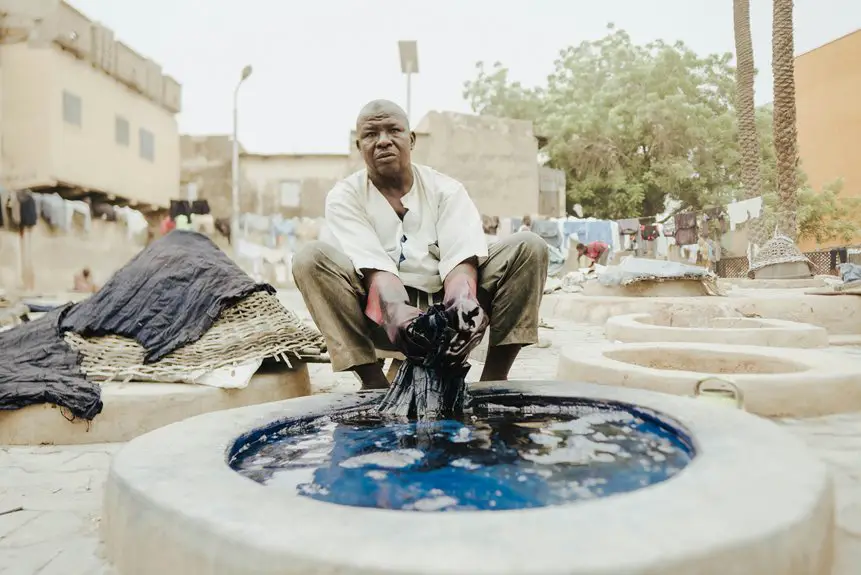To dye velvet fabric successfully, choose the right dye based on its fiber type—acid dyes for natural fibers, disperse dyes for synthetics. Prepare by cleaning and drying the fabric gently to preserve the pile. Submerge velvet slowly in hot water mixed with dye, moving it carefully for even color. Avoid overwetting and prolonged soaking to prevent texture damage. Rich jewel tones work best for velvet’s depth and sheen. Keep these basics in mind, and you’ll discover how to perfect your velvet dyeing technique.
Table of Contents
Key Takeaways
- Use fiber-reactive or acid dyes for natural velvet and disperse dyes for synthetic velvet, testing a small sample first for compatibility.
- Prepare velvet by thoroughly cleaning and air drying to remove oils and finishes that inhibit dye absorption.
- Submerge velvet gently in hot dye bath, moving slowly to avoid crushing the pile and ensure even color distribution.
- Choose deep jewel tones or saturated colors that complement velvet’s texture and avoid pastel or overly bright shades that fade easily.
- After dyeing, hand wash in cold water, avoid wringing, and dry flat away from sunlight to maintain color and fabric integrity.
Understanding Velvet Fabric and Its Dyeing Challenges
Although velvet fabric offers a luxurious texture and rich appearance, you’ll find it presents unique challenges when dyeing. Velvet’s dense pile, made from cut loops of fibers, creates a plush surface that doesn’t absorb dye evenly like flat fabrics do. You’ll notice dyes can settle unevenly, causing blotchy or patchy results if you’re not careful.
Additionally, velvet often combines different fiber types—like silk, cotton, or synthetic blends—which react differently to dyes and temperatures. Handling velvet requires gentle care to avoid crushing its pile or causing shrinkage.
When you dye velvet, you must also consider how the pile direction affects color depth and sheen. Mastering these factors guarantees your velvet pieces look vibrant and maintain their luxurious feel after dyeing.
Choosing the Right Dye for Velvet
Understanding velvet’s unique structure and fiber blend helps you pick the right dye that works best for your fabric. Velvet can be made from natural fibers like silk or cotton, or synthetic ones like polyester, so choosing a compatible dye is vital.
For natural fibers, fiber-reactive or acid dyes provide vibrant, lasting color. Synthetic velvets require disperse dyes specifically designed for polyester or nylon. If your velvet is a blend, you might need a combination or a universal dye formulated for mixed fabrics.
Always check the dye’s specifications and test on a small fabric sample first. Selecting the correct dye guarantees even absorption and prevents damage, helping you achieve rich, consistent color on your velvet project.
Preparing Velvet Fabric for Dyeing
Preparing velvet fabric for dyeing starts with thorough cleaning to remove any dirt, oils, or finishes that could block dye absorption. You want your velvet to be as receptive as possible to the dye, so wash it gently with a mild detergent and rinse well.
Avoid fabric softeners since they can leave residues. After washing, let the velvet air dry completely to prevent uneven dyeing.
Before you dye, consider these key steps to prepare your fabric:
- Handle velvet delicately to preserve its pile and texture
- Avoid wringing or twisting the fabric to prevent damage
- Lay the velvet flat or hang it to dry to maintain shape
- Test a small hidden area to check how the fabric reacts
These steps set you up for vibrant, even color results.
Step-by-Step Guide to Dyeing Velvet at Home
Once you’ve prepped your velvet fabric properly, you can plunge into the dyeing process with confidence.
Start by filling a large basin or bucket with hot water, ensuring it’s deep enough to submerge the fabric fully. Add your chosen dye according to the package instructions and stir well.
Next, immerse the velvet slowly, moving it gently to avoid crushing the pile. Maintain the water temperature and stir periodically for even absorption.
After the recommended time, rinse the fabric under cool running water until it runs clear. Finally, squeeze out excess water carefully without wringing and lay the velvet flat or hang it to dry away from direct sunlight.
This careful approach preserves the texture and vibrant color of your velvet.
Best Practices for Achieving Even Color on Velvet
Achieving an even color on velvet requires careful attention to how you handle and move the fabric during dyeing. You want to guarantee the dye penetrates uniformly without creating patches or streaks.
Keep the fabric consistently submerged and gently agitate it to prevent uneven absorption. Temperature control is vital; maintain a steady heat to help the dye set evenly. Always pre-wet the velvet to help the dye spread smoothly.
To get the best results, remember to:
- Move the fabric slowly and steadily to avoid color blotches
- Use a large enough dye bath for ample fabric movement
- Keep the dye bath at a consistent temperature
- Rinse gently to preserve the even color and fabric texture
Follow these steps, and your velvet will boast rich, uniform color.
Common Mistakes to Avoid When Dyeing Velvet
When dyeing velvet, don’t soak the fabric too much or you risk damaging its texture.
You also need to prepare the fabric properly before starting to guarantee the dye sets evenly.
Plus, picking the wrong type of dye can ruin your results, so be sure to choose the right one for velvet.
Overwetting Fabric Risks
Although it might seem harmless, overwetting velvet fabric during dyeing can cause serious issues. When you soak velvet excessively, the fibers become overly saturated, leading to uneven dye absorption. This results in blotchy or streaky colors that ruin the fabric’s luxurious look.
Plus, too much water weakens the delicate pile, causing matting or loss of softness. You might also face longer drying times, increasing the risk of mildew or unpleasant odors.
Avoid these overwetting pitfalls:
- Uneven, patchy color that disappoints
- Flattened, lifeless velvet texture
- Prolonged drying that invites mold
- Difficulty handling fragile, soaked fabric
Keep your velvet just damp enough for ideal dyeing to protect its rich texture and vibrant color.
Ignoring Fabric Preparation
Overwetting velvet can ruin your dyeing efforts, but even careful moisture control won’t save you if you skip proper fabric preparation.
Before dyeing, you need to thoroughly clean your velvet to remove oils, dirt, or sizing agents that block dye absorption. Skipping this step leads to uneven color and patchiness.
Always pre-wash the fabric with a gentle detergent and rinse well, guaranteeing no residue remains. Also, check for any fabric finishes that might resist dye; if present, treat or remove them according to fabric care instructions.
Preparing velvet properly guarantees the dye penetrates evenly, producing vibrant, consistent results.
Don’t rush this vital step—taking time upfront means your velvet will look professionally dyed and last longer without fading or spotting.
Choosing Wrong Dye Type
Choosing the wrong dye type can sabotage your entire velvet dyeing project. Velvet’s unique texture and fiber content demand specific dyes to achieve vibrant, lasting colors.
If you pick a dye incompatible with your velvet fabric—like using a fiber-reactive dye on synthetic velvet—you’ll face uneven color, fading, or complete dye rejection.
Avoid these pitfalls by understanding your velvet’s fiber type and matching it with the correct dye. Don’t let frustration ruin your creative process.
- Feeling disappointed by dull, patchy results
- Wasting time and money on unsuitable dyes
- Struggling with color bleeding or fading
- Losing the luxurious feel and look of velvet
Choose your dye wisely to preserve velvet’s elegance and your satisfaction.
Color Selection Tips for Velvet Fabrics
When picking colors for your velvet, focus on vibrant shades that highlight its rich texture.
Remember, the fabric’s pile can affect how the color appears, so consider how light plays on the surface.
Also, match your chosen colors to the intended use to guarantee the best look and feel.
Choosing Vibrant Velvet Shades
Although velvet’s rich texture can intensify any hue, selecting the right shade requires careful consideration of how light interacts with the fabric’s pile. You want colors that pop without losing depth or appearing dull.
Opt for shades that reveal subtle shifts when viewed from different angles, enhancing velvet’s natural luster.
When choosing vibrant velvet shades, keep these tips in mind:
- Pick jewel tones like emerald, sapphire, or ruby for a luxurious, eye-catching effect.
- Consider deep, saturated colors that maintain richness even in low light.
- Test small fabric swatches under various lighting to observe color shifts.
- Avoid overly bright or pastel shades that may wash out or look flat on velvet.
Considering Fabric Texture Impact
Since velvet’s texture plays an essential role in how colors appear, you’ll want to take into account the fabric’s pile and weave before finalizing your shade.
The pile’s direction can create subtle color shifts when light hits different angles, so darker hues might appear richer, while lighter colors could seem more muted.
When selecting your dye, consider how the velvet’s nap affects color absorption—thicker piles often hold dye unevenly, leading to variations in tone. You can enhance depth by choosing shades that complement the fabric’s natural sheen.
Keep in mind, too, that velvet with a tight weave tends to show colors more uniformly, whereas looser weaves might result in a softer, blended look.
Factoring in these texture details helps you achieve the exact velvet color you want.
Matching Colors to Use
Because velvet’s unique texture influences how colors appear, you’ll want to choose shades that enhance its luxurious depth. Rich, saturated hues work best, as they bring out velvet’s natural sheen and softness.
Avoid pale or washed-out colors—they can make the fabric look flat or lifeless. Think about the mood you want to create; deep jewel tones evoke elegance, while vibrant colors add boldness. When selecting colors, keep in mind how light interacts with velvet’s pile to create subtle shifts in shade.
- Choose deep blues, emerald greens, or ruby reds to highlight velvet’s richness
- Opt for warm tones like burgundy or chocolate to add warmth and coziness
- Select colors that complement your space or outfit for a harmonious look
- Experiment with darker shades to emphasize velvet’s plush texture and depth
Caring for Dyed Velvet to Preserve Color and Texture
When you care for dyed velvet properly, you help maintain its rich color and soft texture for years.
Always hand wash velvet in cold water with a mild detergent to prevent color fading. Avoid wringing or twisting the fabric; instead, gently press out excess water.
Hand wash velvet gently in cold water with mild detergent; press, don’t twist, to keep colors vibrant.
Lay it flat on a clean towel to dry, keeping it away from direct sunlight, which can dull colors. If you need to iron, use a low setting with a cloth barrier to protect the pile.
Store velvet items in a cool, dry place, preferably hanging to avoid creases.
Creative Dyeing Techniques to Enhance Velvet Appearance
Although dyeing velvet requires care to protect its delicate pile, you can experiment with creative techniques to make your fabric truly stand out.
Try tie-dyeing to create mesmerizing patterns that catch the light differently across the soft surface. Ombre dyeing gradually shifts colors, adding depth and drama to the fabric’s natural sheen. You might also explore resist dyeing, using wax or stencils to craft intricate designs that pop against the velvet’s plush texture.
Finally, layering dyes can produce rich, multi-dimensional hues that play with velvet’s reflective qualities.
- Feel the thrill of transforming simple velvet into a vibrant masterpiece.
- Watch colors dance and shift as light hits every fiber.
- Release your creativity with personalized, one-of-a-kind designs.
- Experience the joy of crafting tactile, luxurious art you can wear or display.
Frequently Asked Questions
Can Velvet Fabric Be Machine Washed After Dyeing?
You shouldn’t machine wash velvet fabric after dyeing, as it can damage the fibers and fade the color. Instead, hand wash it gently in cold water to preserve the dye and keep the fabric soft and vibrant.
How Long Does Dyed Velvet Fabric Take to Fully Dry?
Good things come to those who wait—dyed velvet fabric usually takes 24 to 48 hours to fully dry. You’ll want to air dry it flat, avoiding direct sunlight to keep colors vibrant and fabric soft.
Is It Possible to Remove Dye From Velvet if Color Is Uneven?
Yes, you can remove uneven dye from velvet by using a dye remover or color stripper. Just follow instructions carefully, test on a small area, and remember velvet’s delicate texture requires gentle handling to avoid damage.
What Are the Environmental Impacts of Dyeing Velvet at Home?
When you dye velvet at home, you’re likely using chemicals that can harm water sources if not disposed of properly. You should handle dyes carefully and avoid pouring leftover dye down the drain to protect the environment.
Can Velvet With Metallic Threads Be Safely Dyed?
You can dye velvet with metallic threads, but you’ve got to be careful. Metallic fibers may react poorly to dyes or heat, so test a small area first and choose gentle, low-temperature dyeing methods to avoid damage.
- Does Chiffon Fabric Stink - July 15, 2025
- Does Chiffon Fabric Affect the Economy - July 15, 2025
- Does Cotton Fabric Have a Nap - July 15, 2025





